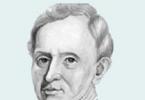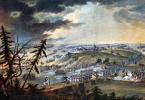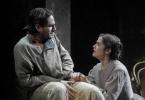Ivan Bunin, “Lapti” (a brief summary follows) is a short story with a seemingly simple plot. However, Bunin’s talent lies in the fact that when you read his works, you guess yourself or a story you heard just now with a tragic ending...
Sometimes late in the evening, when it’s completely dark, you go to the window, look out onto the street, and there are hundreds of thousands of windows. Some glow with a bright yellow light, others are dark, but behind each of them you can read its own story, its own story, its own plot develops...
So in Bunin's prose - gray everyday life with its curiosities and incidents. However, there is one “but” that cannot be expressed in one word, or even words. It reaches to the very depths of the human soul and brings out something truly living, real, something that you are afraid to miss, to lose again in this thickness of misunderstanding, in an endless string of words and actions. So..
Ivan Bunin, “Lapti”: summary
Winter. The fifth day is an impenetrable blizzard and blizzard. Not a soul around. Outside the windows of one farm house there is grief - a child is seriously ill. Despair, fear and helplessness took over the mother's heart. My husband is away, he can’t get to the doctor, and he himself won’t be able to get there in this weather. What to do?
There was a knock in the hallway. It was Nefed who brought straw for the stove. A minute or two later he looked into the room to ask about the child's health. It turned out that the boy was very weak, he was on fire, most likely he would not survive, but the main thing was that in his delirium he kept mentioning some red bast shoes, asking for them...
Without hesitation, Nefed goes to the neighboring village for new bast shoes and for magenta - red paint: if he asks, it means his soul desires it, and he must definitely go and get it...

The night passed in anxious anticipation.
In the morning there was an ominous knock on the window. These were men from a neighboring village. They brought Nefed's frozen body. We discovered it by accident when we ourselves fell into a snow hole and were already desperate to escape. But when they saw the frozen body of Nefed, whom they knew, they realized that the farm was very close. They strained their last strength and reached the people.
In his belt, under the man's sheepskin coat, lay new children's bast shoes and a bottle of magenta. This is how the story (I.A. Bunin) “Lapti” ends, a brief summary of which was outlined above.
Main idea: “Lapti”, Bunin I. A.
The last sentence, period, end of the story. While reading a particular work, we are more captivated by the plot than by what is hidden behind the words and actions of the main characters. However, then hundreds of thoughts come: why, for what, why... The story that Ivan Bunin wrote - “Lapti” - is, first of all, an ode to extraordinary kindness and readiness for self-sacrifice. But this is just the tip of the iceberg, the first layer that invites you to dig further and discover new and unexpected riches. What else is hidden behind the “scenery” of the unfolding drama?
A merciless element rules outside the window, ready to destroy anyone who dares to resist it. Death is on the threshold, waiting in the wings without pity and unnecessary doubts. The inconsolable mother humbly freezes before her. And only Nefed shows the determination to resist these two inevitabilities and follow the dictates of the soul.
And at this moment the reader is overcome with feelings that are difficult to convey in words. It’s as if a thin thread of light, something inexplicable, and at the same time painfully familiar, penetrates, passes through and connects souls, destinies and circumstances. Nefed does not try to explain his, at first glance, extravagant desire to go for bast shoes in an impassable blizzard and blizzard. He knows one thing - the soul desires, and here it is sinful to reason and argue. The question arises: whose soul called him on the road: a dying boy, an inconsolable mother, himself, or those lost men? The seemingly absurd, and sometimes even stupid, death of Nefed becomes significant, and, one might say, a necessary sacrifice. She gave the right to life to those lost men from the neighboring village, and perhaps even to a child.

Once again I would like to remind you that this story, written by Ivan Alekseevich Bunin, is called “Lapti”. A summary, of course, cannot convey all the subtlety and depth of feelings of the main characters, so reading the original is simply necessary.
A story about human mercy and compassion. Village resident Nefed is very worried about his owner’s boy, who is lying with a high fever. No doctor can get to such a fierce cold and the child is treated as best they can. In his delirium, the master's son asks to bring him red bast shoes, and the kind Nefyod decides to fulfill the boy's request, although he understands that there is a snowstorm outside. At dawn, Nefed is found dead, but with bast shoes: he got them, but at the cost of his own life.
The main idea is that everything in the world can be done for a child to alleviate his suffering.
Read a summary of Lapti Bunin's story
The story takes place in a run-down village in the bitter winter. The woman's child became very ill. He lay with a high fever and was burning and delirious. The winter this year turned out to be severe: the blizzard did not subside for five whole days. The child felt bad. Crying and begging his mother, the boy for some reason asked to get him some sandals. At first, the woman decided that her son’s temperature was rising even higher, since he was asking for something unknown. And the boy persistently begged to get him bast shoes, but not the usual ones they wear in the village, but red ones. He cried endlessly, and his mother, out of helplessness, also could not hold back her tears. It seemed to her that the boy was delirious, and maybe these were his last days. Out of fear, she prayed and cried even more.
And outside the windows the snow kept falling and falling. The woman didn't know what to do. Her husband had gone somewhere far away, and getting to the doctor was out of the question. She understood perfectly well that the horses would not go far through the snowdrifts, and the hospital was very far away, and even the doctor would not get to them in such a snowstorm. All we could do was wait and hope.
When the door in the hallway knocked, the woman looked in that direction. It turned out that it was her servant Nefed who brought straw to light the stove. He hesitated, and then carefully looked into the room where the sick child lay. He nodded his head and quietly asked how the boy was feeling. The upset woman said that she had already lost hope that the boy would feel better. In bewilderment, she told Nefed that the child, as if in delirium, kept asking for some kind of red bast shoes. The servant was surprised by the patient’s quirk, scratched the back of his head, and decided to find such bast shoes, since the child was asking for it. The woman was seriously alarmed. She began to say that it was bitterly cold outside, and that there was nowhere to get red bast shoes. Nefyod realized that he could paint bast shoes with magenta, but to do this he needed to go to a shop in a neighboring village. He assumed that it would be difficult to get there on horseback, and decided that he would somehow get there on foot. He said and left. In the kitchen, Nefyod put on a warmer sheepskin coat, wrapped a sash around him so that the wind wouldn’t open the floors, and went through the deep snowdrifts to paint his bast shoes.
Time has passed. Everyone in the house had already had dinner a long time ago, but Nefed still did not return. It was assumed that the servant must have stayed overnight somewhere, but that didn’t make it any easier. All the household members were worried about Nefyod, and their souls were restless. The wind whistled outside the windows and a blizzard blew. An inconsolable mother sat at the child’s head, and a lit candle stood nearby. The woman put it on the floor so that the light would not seem bright to her boy. She sat next to her son, neither alive nor dead. And the son continued to burn. He tossed about in delirium and with tears begged for red bast shoes. Some shadows were reflected from the candle on the wall, and it seemed to the child that the entire wall was on fire, and some figures were dancing there. The whole night was tense, and when dawn came, everyone breathed a sigh of relief. Some voices and footsteps were heard on the street. The woman listened. Now she clearly understood that someone had arrived. She heard someone persistently knocking on the window. These were several men from Novosyolki, from the village where Nefed had gone the day before. They brought an icy body that lay on a sled. It was Nefed, frozen in the snow. The men told how they discovered the body. It turns out that they were driving from the city, and drove around in the snowdrifts for a long time until they got stuck. So they wandered all night.
In the morning, when it dawned, they and their horse were carried into some meadows. The men were completely disheartened. With such a blizzard, they lost their way and decided that this was where they would end their existence. They realized that they would no longer be able to get out of the snowdrifts. And suddenly they discovered that something was sticking out of the snow. Taking a closer look, the men saw that someone’s feet in felt boots were sticking out of the snowdrift. Apparently some person froze in the snow. Gathering their last strength, the men began to clear away the rubble. When they cleared the snow from their face, they realized that it was Nefed from the neighboring village. Then they roughly understood where they were and that the village was just a stone's throw away. They loaded the body onto the sled and began to move slowly.
Poor Nefed lay dead, and no one could believe it. But the most surprising thing was that in his bosom he had new children's bast shoes for a sick boy, and next to him a small bottle of magenta.
Reader's diary.
I. A. Bunin wrote the story “Lapti” in the summer of 1924. The humanistic orientation of this work is very obvious. The summary of the story “Lapti” by Bunin focuses specifically on the human soul, which is the highest moral value. Nefed’s act is not considered a heroic deed, but what a powerful moral force is present in his desire to help a dying child!
Bunin, “Lapti”: summary
For five days now, an impenetrable blizzard has been sweeping the farmstead, everything around is white and white with snow. In one of the huts, gloomily, delirious and hot, a sick child lies in his bed and tearfully begs his mother to give him red bast shoes. A woman cries in despair, her husband is away. She can’t hope for a doctor to arrive at this time.
This is how Bunin twists the plot tragically. “Lapti” continues its brief content with the fact that suddenly there was a knock on the door in the corridor, it was the man Nefed who came, bringing straw for the stove. Having learned that the child is raving about red bast shoes, he decides to go to the nearest village of Novoselki, several miles away, and buy bast shoes and magenta from the store, with which he will paint them red.

Savior
He decided not to take horses, since there was no way to get there. He left and did not return for a long time. Everyone thought that he had stayed overnight in the village, which made the night seem even more terrible. The child did not stop asking his mother for red bast shoes, and she stood on her knees and asked the Lord for help and protection.
At dawn, voices were heard in the yard, then someone knocked on the window. It was the Novosel men who brought Nefed’s stiff, dead body. It turns out that they were traveling from the city, their carriage overturned, and they got lost, completely despairing of finding the way, they thought that they would be lost. But then we saw feet in felt boots sticking out of the snow. They raked and recognized Nefed, and then they realized that the farm was already nearby.
This is how Bunin finished Lapti. The summary of the work indicates that children's sandals and a bottle of magenta were then found in his bosom.

Conclusion
Analyzing the topic “Bunin, “Lapti”: summary”, it is necessary to note the main thing - the strong prayer of the child’s mother to God. Therefore, the simple man Nefed became that atoning sacrifice, thanks to which the blizzard probably ended, and the child recovered, and the lost men were saved. And the red color of the bast shoes became a symbol of purification, love, mercy and self-sacrifice that Jesus Christ brought to the world. Thus, Nefed became, as it were, the personification of the Savior himself.
Title of the work: Lapti
Year of writing: 1924
Genre: story
Main characters: grandfather Nefed, his grandson
Plot
A storm raged on a small farm for several days and blocked all the roads. In a lonely hut, a boy is very sick, he is delirious in the heat, and in his delirium he begs his mother to give him red bast shoes. He constantly repeats the same thing: “Mommy, give it!” The boy's grandfather, having learned about his request, found a way out of the situation: he had to go to the neighboring village 6 miles away and buy children's bast shoes there and paint them red. Despite the bad weather, the grandfather left. He did not return either for lunch or in the evening. The mother was not worried; she decided that he had decided to spend the night with relatives.
But in the morning there was a knock on the window and strange voices were heard: men from a neighboring village brought the body of a frozen old man, he was found in a snowdrift. In the grandfather's bosom they found small shoes and a bottle of magenta for coloring them.
Conclusion (my opinion)
The grandfather loved his grandson so much and was worried about him that it was only natural for him to go out in stormy weather to get a gift. He probably understood that walking several miles in such weather was dangerous, but the life and health of the sick boy was much more important to him than his own safety and even life. HE did not know how to speak beautiful words, and did not promise anything to the sick child, he just went and did what, in his opinion, needed to be done.
Bunin's story "Lapti" was written in 1924, after the writer moved to France. In his book, he described the life of pre-revolutionary Russia and with great love revealed the original character of the Russian people.
For a reading diary and preparation for a literature lesson, it is recommended to read online a summary of Lapti. You can test your knowledge using a test on our website.
Main characters
Nefed- a simple Russian peasant with a big heart.
Other characters
Child- a seriously ill boy.
Mother– mother of a sick child, kind and loving woman.
Short description
“Great grief” comes to the manor’s house - a child becomes very ill. The unfortunate mother is in despair: her husband is away, and “the doctor is thirty miles away.” A blizzard has been raging for five days now, and in such weather not a single doctor will be able to come to a sick child.
The old faithful servant Nefed learns from the lady that the boy, in extreme delirium, is constantly asking for some red bast shoes. After thinking a little, the man firmly declares: “So, we need to get it.” This means the soul desires.”
He believes that it is not difficult to fulfill a child’s wish. The only thing to do is buy new bast shoes and paint them magenta. But getting to the nearest shop in Novoselki, located six miles from the manor’s house, is a much more serious task in such bad weather.
The woman tries to dissuade Nefed from this idea, but in vain. Night falls, the house is buried “in the abyss of a snow hurricane and darkness,” and everyone decides that Nefed in Novoselki “stayed overnight if God informed.”
All night, the mother of a sick child, tormented “from fear and from her helplessness,” whispers prayers and asks the Lord for help.
The next morning, the Novosel men bring the body of “white, frozen, completely covered with snow” Nefed. Having gotten lost during a snowstorm, they were able to find their way only thanks to Nefed’s felt boots sticking out of the snow. In his bosom they found “new baby shoes and a bottle of magenta.”
Conclusion
This story teaches kindness, compassion, mercy. Nefed is a collective image of the simple Russian people, capable of sacrificing themselves to save human life.
Story test
Check your memorization of the summary content with the test:
Retelling rating
Average rating: 4.5. Total ratings received: 777.




